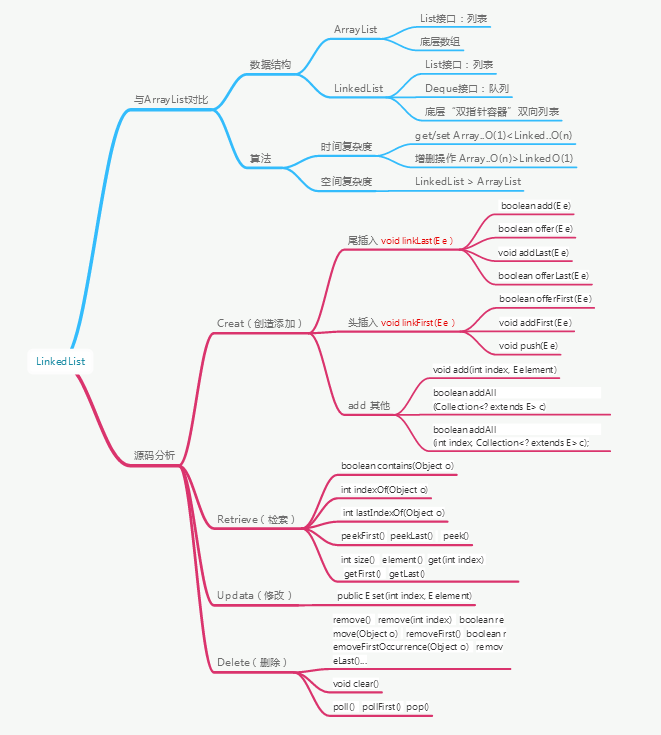本文出自:https://blog.csdn.net/DT235201314/article/details/80421037
一丶概述
上篇说到ArrayList及源码,这篇说说LinkedList及源码
二丶正文
1.目录图
2.ArrayList与LinkedList区别
(1)数据结构
ArrayList,List()接口,列表,想象结构如下图:
底层为数组,单向。
LikedList实现List()接口,Deque接口,双向链表,想象结构如下:
底层为内部实体类,双向链表。
(2)复杂度
空间复杂度:LinledList装的实体类,且有正反向“指针参数”,大于ArrayList。
时间复杂度:LinkedList继承了AbstractSequentialList并且实现List,Deque,Cloneable, Serializable接口。
其中,AbstractSequentialList相较于AbstractList(ArrayList的父类),只支持次序访问,而不支持随机访问,因为它的
get(int index) ,set(int index, E element), add(int index, E element), remove(int index) 都是基于迭代器实现的。所以在LinkedList使用迭代器遍历更快。
get/set ArrayListO(1)<LinkedListO(n)增删操作 Array..O(n)>LinkedO(1)
3.源码分析
(1)继承关系:
public class LinkedList<E> extends AbstractSequentialList<E> implements List<E>, Deque<E>, Cloneable, java.io.Serializable1.从图中我可以看出LinkedList实现了Deque接口,可以将LinkedList当做队列使用;实现了cloneable表示能被克隆,实现了Serializable接口表示支持序列化;
2.LinkedList基于双向链表,实现了所有List操作并允许所有元素包括null值,它可以被当作双端队列;
3.LinkedList顺序访问非常高效,而随机访问效率很低;
4.LinkedList线程不安全,可以用Collections.synchronizedList使其线程安全。
(2)相关字段
/** * LinkedList长度,不可序列化 */ transient int size = 0; /** * 首结点 */ transient Node<E> first; /** * 尾结点 */ transient Node<E> last;
/** * 内部实体类,泛型数值与正反向“指针”参数标签 * @param <E> */ private static class Node<E> { E item; Node<E> next; Node<E> prev; Node(Node<E> prev, E element, Node<E> next) { this.item = element; this.next = next; this.prev = prev; } }
(3)构造方法
/** * Constructs an empty list. */ public LinkedList() { } /** * 参数Collection的构造方法 */ public LinkedList(Collection<? extends E> c) { // 调用无参构造函数 this(); // 添加集合中所有的元素 addAll(c); }
(4)方法介绍
Creat(创造添加)方法
LinkedList新增(public)有如下几个方法:
public boolean add(E e);
public boolean offer(E e);
public void addLast(E e);
public boolean offerLast(E e);
/** * 末尾插入元素 */ public boolean add(E e) { linkLast(e); return true; } public boolean offer(E e) { // 尾插元素 return add(e); } /** * 尾插元素 */ public void addLast(E e) { linkLast(e); } /** * 尾插元素 */ public boolean offerLast(E e) { addLast(e); return true; } /** * 尾插元素 */ void linkLast(E e) { //获取当前尾结点 final Node l = last; //定义新结点,其前驱结点为尾结点,值为e,后继结点为null final Node newNode = new Node<>(l, e, null); //将刚定义的新节点设为尾结点 last = newNode; //若原尾结点为null,即原链表为null,则链表首结点也为newNode if (l == null) first = newNode; //若不是原尾结点的后继设为newNode else l.next = newNode; //长度+1 size++; //改变次数+1 modCount++; }核心方法linkLast
头部插入方法:
public boolean offerFirst(E e);
public void addFirst(E e);
public void push(E e);
/** * 头插指定元素 */ public void addFirst(E e) { linkFirst(e); } public void push(E e) { addFirst(e); } /** * 头插指定元素 */ public boolean offerFirst(E e) { addFirst(e); return true; } /** * 头插 */ private void linkFirst(E e) { //获取当前首结点 final Node f = first; //定义新结点,前驱为null,结点值为e,后驱为f final Node newNode = new Node<>(null, e, f); //将newNode设为首结点 first = newNode; //若首结点为null,尾结点设为newNode,若不是原首结点前驱设为newNode if (f == null) last = newNode; else f.prev = newNode; //长度+1 size++; modCount++; }
正常添加:
public void add(int index, E element);
public boolean addAll(Collection<? extends E> c);
public boolean addAll(int index, Collection<? extends E> c);
/** * 指定位置插入元素 */ public void add(int index, E element) { // 判断索引是否越界 checkPositionIndex(index); // 若指定位置在尾部,则尾插元素;若不在调通用方法指定位置插入 if (index == size) linkLast(element); else linkBefore(element, node(index)); } /** * 尾插集合所有元素 */ public boolean addAll(Collection c) { return addAll(size, c); } /** * 指定位置插入集合所有元素 */ public boolean addAll(int index, Collection c) { //判断索引是否越界 checkPositionIndex(index); //将集合转为数组 Object[] a = c.toArray(); //获取数组长度 int numNew = a.length; //若数组长度为0,即没有要插入的元素返回false if (numNew == 0) return false; //succ为原index位置上结点,pred为succ前驱结点 Node pred, succ; //若是尾部,succ为null,pred为尾结点 if (index == size) { succ = null; pred = last; //若不是succ为index位置结点,pred为其前驱结点 } else { succ = node(index); pred = succ.prev; } //for循环遍历集合 for (Object o : a) { @SuppressWarnings("unchecked") E e = (E) o; //定义一个新结点,其前驱结点为pred,结点值为e,后继结点为null Node newNode = new Node<>(pred, e, null); //若前驱结点为null,则将newNode设为首结点 if (pred == null) first = newNode; else //若存在前驱结点,将其后继赋为newNode pred.next = newNode; //类似于迭代器的next,将newNode指向下一个需插入结点位置的前驱 pred = newNode; } //若是尾插,则最后添加元素为尾结点 if (succ == null) { last = pred; } else { //若不是,最后添加的结点后继指向原index位置上的succ pred.next = succ; //succ的前驱指向最后添加的结点 succ.prev = pred; } //长度+numNew size += numNew; modCount++; return true; } private void checkPositionIndex(int index) { //若index不在[0,size]区间内则抛越界异常 if (!isPositionIndex(index)) throw new IndexOutOfBoundsException(outOfBoundsMsg(index)); } private boolean isPositionIndex(int index) { return index >= 0 && index <= size; } /** * 获取指定位置结点 */ Node node(int index) { // 若指定索引小于LinkedList长度一半,则从首结点开始遍历;若不是从尾结点开始遍历 if (index < (size >> 1)) { Node x = first; for (int i = 0; i < index; i++) x = x.next; return x; } else { Node x = last; for (int i = size - 1; i > index; i--) x = x.prev; return x; } } /** * 中间插入 */ void linkBefore(E e, Node succ) { // 获取原索引上元素前驱结点pred final Node pred = succ.prev; // 定义新结点,其前驱结点为pred,结点值为e,后继为succ final Node newNode = new Node<>(pred, e, succ); // 将succ的前驱结点设为newNode succ.prev = newNode; // pred为空,即succ为原首结点,那么将新定义的newNode设为新首结点 if (pred == null) first = newNode; else //否则pred后继结点设为newNode pred.next = newNode; //长度+1 size++; //修改次数+1 modCount++; }
双向表添加图示:
Updata (修改)方法
public E set(int index, E element);
/** * 修改指定位置结点值,返回被替换结点值 */ public E set(int index, E element) { //校验index是否越界 checkElementIndex(index); //获取当前index位置上结点 Node x = node(index); //获取此结点值 E oldVal = x.item; //修改结点值 x.item = element; //返回被替换结点值 return oldVal; }
Delete(删除)方法:
public E remove();
public E remove(int index);
public boolean remove(Object o);
public E removeFirst();
public boolean removeFirstOccurrence(Object o);
public E removeLast();
public boolean removeLastOccurrence(Object o);
public void clear();
public E poll();
public E pollFirst();
public E pop();
/** * 获取并删除首结点值,若链表为空则抛出异常 */ public E remove() { return removeFirst(); } public E pop() { return removeFirst(); } public E removeFirst() { final Node f = first; if (f == null) throw new NoSuchElementException(); return unlinkFirst(f); } /** * 获取并删除首结点,若链表为空返回null */ public E poll() { final Node f = first; return (f == null) ? null : unlinkFirst(f); } public E pollFirst() { final Node f = first; return (f == null) ? null : unlinkFirst(f); } private E unlinkFirst(Node f) { //获取首结点值 final E element = f.item; //获取首结点后继 final Node next = f.next; //删除首结点 f.item = null; f.next = null; // help GC //原后继结点设为首结点 first = next; //若后继结点为null,尾结点设为null;若不是后继结点的前驱结点设为null if (next == null) last = null; else next.prev = null; //长度-1 size--; modCount++; return element; } /** * 删除指定位置结点 */ public E remove(int index) { //校验index是否越界 checkElementIndex(index); return unlink(node(index)); } /** * 删除指定结点 */ E unlink(Node x) { // 获取指定结点值 final E element = x.item; // 获取指定结点后继 final Node next = x.next; // 获取指点结点前驱 final Node prev = x.prev; // 若前驱为null,则后继结点设为首结点 if (prev == null) { first = next; } else { //若不是,指定结点后继结点设为指定结点前驱结点后继,指定结点的前驱设为null prev.next = next; x.prev = null; } //若后继结点为空,则前驱结点设为尾结点 if (next == null) { last = prev; } else { //若不是,指定结点前驱结点设为指定结点后继结点前驱,指定结点的后继设为null next.prev = prev; x.next = null; } //指定结点值设为null x.item = null; //长度-1 size--; modCount++; //返回被删除的结点值 return element; } /** * for循环从头遍历,删除第一次出现的指定元素 */ public boolean remove(Object o) { if (o == null) { for (Node x = first; x != null; x = x.next) { if (x.item == null) { unlink(x); return true; } } } else { for (Node x = first; x != null; x = x.next) { if (o.equals(x.item)) { unlink(x); return true; } } } return false; } /** * 删除从头开始第一出现的指定结点 */ public boolean removeFirstOccurrence(Object o) { return remove(o); } /** * 删除尾结点,若链表为空抛异常 */ public E removeLast() { final Node l = last; if (l == null) throw new NoSuchElementException(); return unlinkLast(l); } /** * 删除尾结点,若链表为空返回null */ public E pollLast() { final Node l = last; return (l == null) ? null : unlinkLast(l); } /** * 删除尾结点 */ private E unlinkLast(Node l) { // 获取尾结点值 final E element = l.item; // 获取尾结点前驱 final Node prev = l.prev; // 删除尾结点 l.item = null; l.prev = null; // help GC // 将原尾结点前驱设为尾结点 last = prev; // 若原尾结点的前驱结点为空,则首结点设为null if (prev == null) first = null; else //若不为null,原原尾结点的前驱结点的后继结点设为null prev.next = null; //长度-1 size--; modCount++; return element; } /** * 删除最后出现的结点 */ public boolean removeLastOccurrence(Object o) { if (o == null) { for (Node x = last; x != null; x = x.prev) { if (x.item == null) { unlink(x); return true; } } } else { for (Node x = last; x != null; x = x.prev) { if (o.equals(x.item)) { unlink(x); return true; } } } return false; } /** * 清空LinkedList */ public void clear() { //循环遍历LinkedList,删除所有结点 for (Node x = first; x != null; ) { Node next = x.next; x.item = null; x.next = null; x.prev = null; x = next; } //首尾结点置空 first = last = null; //长度设为0 size = 0; modCount++; }
删除图解:
四丶参考文章
写在最后微信扫码提问





